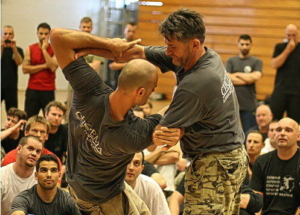Understanding Flow in Systema
Like many of you one of the things that attracted me to systema was its free flowing movements. I remember watching Vladimir Vasiliev move for the first time and I was struck by the ease and freedom with which he moved, seemingly controlling the attacker from start to finish. One movement would flow smoothly into the next until the attack had been neutralised. Students would often say that it seemed like he knew what the attacker’s next move was, but I don’t think that is an accurate description. I think a better way to describe it is that he is able to ride the attack, much like a surfer on a wave, flowing with the attacker’s movement and seizing opportunities as they present themselves rather than having a fixed outcome or technique in his mind.
By not having a fixed response in mind you are better prepared, both physically and psychologically, to respond to the unpredictable nature of combat. Whereas when you try to force a particular technique to a situation where it is no longer applicable it leads you down a path of tension, frustration and a waste of energy.
Flow is not something you do or achieve but rather something you get out of the way of. We all have the ability to make our systema flow continuously and smoothly like Vladimir’s. So the problem is not that you can’t flow but rather that your flow is bound by your own tension and fear. So the goal of training should be to experience your natural flow state by releasing your tension and fear. It is important that you understand that tension and fear are synonymous with each other. Tension is the physical expression of fear while fear is the psychological manifestation of tension.
So how do we release tension/fear so that we can experience unbound flow? Well the good news is that drills we use in systema are automatically designed to do this if they are done correctly. The following points should be kept in mind to help maximise your natural flow state when training:

To sum it up for me flow is best exemplified by water. No matter what obstacles are placed in its way it always follows the path of least resistance to find its way around. Fear and tension are like the cold which causes the water to turn to ice. While the waters potential to flow freely is still present it is trapped so long as it remains frozen only being released again once heat is applied to melt the ice back into water. In our case we need to unbind our own tension and fear through proper training. So next time your training try and put some of these training ideas in place and see if you can’t unbind your own natural flow state.
